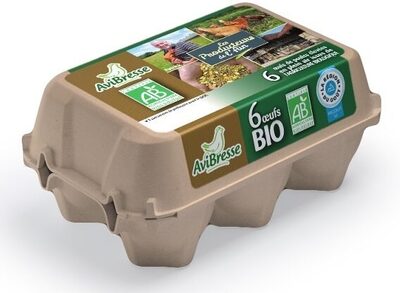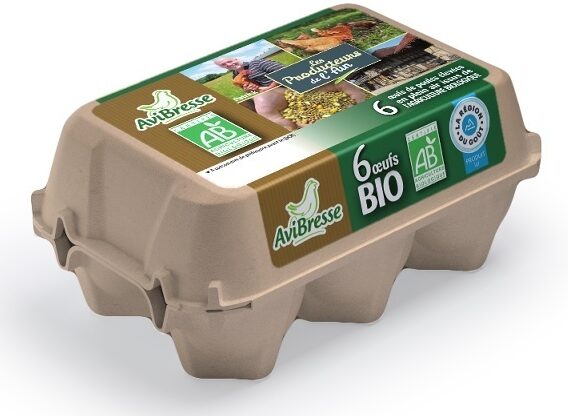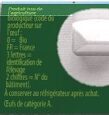6 œufs AviBresse de poules élevées en plein air issus de l'agriculture biologique
Some of the data for this product has been provided directly by the manufacturer Envie d'oeufs.
Barcode: 3760139470064 (EAN / EAN-13)
Common name: Œufs de poules élevées en plein air issus de l'agriculture biologique
Quantity: 6
Packaging: Box, Cardboard, fr:Cellulose
Brands: AviBresse, Les Producteurs de l'Ain
Categories: Farming products, Eggs, Chicken eggs, Free-range chicken eggs, Fresh eggs, fr:Œufs bio
Labels, certifications, awards:
Organic, EU Organic, FR-BIO-10, AB Agriculture Biologique

Origin of the product and/or its ingredients: Ain, France France, Ain
Origin of ingredients: France, fr:Ain
Producer: AviBresse
Manufacturing or processing places: Chalamont, Ain, France
Traceability code: FR 01.074.001 CE - Chalamont (Ain, France)
Link to the product page on the official site of the producer: https://www.lesproducteursdelain.com/blo...
Stores: France, carrefour.fr
Countries where sold: France
Matching with your preferences
Other information
Preparation: Faire bouillir de l'eau dans une casserole. À partir de l'ébullition : 3 minutes = œuf à la coque - 6 minutes = œuf mollet - 9 minutes = œuf dur.
Recipe idea: Tarte bressane : https://www.bourgenbressetourisme.fr/entre-lyon-geneve-macon/recettes/tarte-bressane/
Conservation conditions: À conserver au réfrigérateur après achat. À consommer de préférence avant la Date de Consommation Recommandée (DCR) : voir sur le dessus de l'emballage.
Period of time after opening: fr:28 jours après la date de ponte.
Recycling instructions - To recycle: Boîte et étiquette à recycler.
Customer service: AVIBRESSE - 66 route de pont d'ain - 01320 Chalamont
Report a problem
Data sources
Product added on by kiliweb
Last edit of product page on by packbot.
Product page also edited by driveoff, mylabelcontributors, openchris, openfoodfacts-contributors, org-envie-d-oeufs, sfer, yuka.WmZnL0t2MGFnZWtVd3ZjaTVqbnlvOTE4M3E2U1ZFeWFON0FQSWc9PQ.












